It was a summer afternoon in the late 1970s when Janie Burford clambered over a fence into Painshill Park to explore the mysterious wilderness beyond.
Janie was at the time studying for a postgraduate diploma in landscape architecture at Thames Polytechnic, where she had attended a series of lectures on Painshill, one of the foremost ‘classical' landscapes of the 18th century.
Created by Charles Hamilton between 1738 and 1773, Painshill had been relatively well maintained by successive owners through the 19th and early 20th centuries, but had fallen prey to neglect since the end of the Second World War.
In 1948 the estate had been divided up and sold off in lots to pay taxes. The main part of the ornamental landscape around the lake was developed for commercial forestry, disappearing beneath a blanket of conifers.
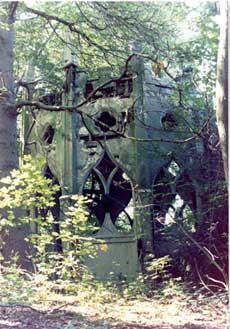
The Gothic Temple, before restorationJanie's opportunity to explore the park arose through a friend, whose mother was resident in part of Painshill House. Together, the pair began to push their way through thick, tangled undergrowth, and trees so crowded they cut out the light.
‘It was a dark, dense jungle. Despite knowing a little of the history, I simply couldn't believe anything would have survived, or that we would find any evidence of Hamilton's masterpiece.' Janie recalls.
Stumbling around the site, the pair came across the ghostly remains of garden buildings such as the Gothic Temple and the Grotto. Deep in the woodland and scrub of what Janie later realised had been the large open space of the Amphitheatre, they found the broken base of a large, empty statue plinth, choked with tree growth. This, they later discovered was where the John Cheere sculpture, the Rape of the Sabines, had once stood.
‘It was one of those life-changing moments. It was an incredible experience, and it became embedded in my mind,' says Janie wonderingly.
Early career
Janie's first degree was in art and design in the 1960s. She went to work for architects the Grima Brothers and then for Fitch & Co, a design branch of the growing Conran empire. After travelling and working in South Africa for a year, Janie formed a design partnership, Mainman Associates, with a former Conran colleague.
Moving on to study landscape architecture in the mid-1970s, Janie combined her studies at Thames Polytechnic with consultancy on the design of buildings and landscape at the Home Office.
Much of the work involved historic buildings and landscape, and Janie became increasingly aware of, and concerned about, the vulnerability of neglected historic sites and the conservation issues involved.
After completing her diploma, Janie grew restless at the Home Office, and then fate seemed to show its hand. A neighbour in Kew, perusing the pages of the Estates Gazette, spotted an advertisement for the post of landscape agent at Painshill.
The neighbour, although she had no particular knowledge of Janie's interest in Painshill, cut out the advertisement and posted it through Janie's letterbox.
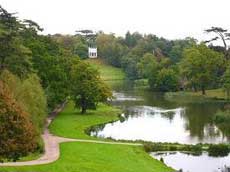
View across the lake to the Gothic TempleSince 1974, Elmbridge Borough Council had been pursuing an enlightened policy - unique for a local authority at the time - of trying to rescue Painshill by buying up parcels of the land that had originally formed the 250-acre estate.
By 1981, councillors had acquired 158 acres of land around the lake, which formed the main ornamental landscape of Painshill. With a £25,000 grant from Surrey County Council and £45,000 from the Countryside Commission, they handed Janie the remit to restore the landscape to Hamilton's original vision and to open Painshill to the public.
Following Janie's appointment in April 1981, the Painshill Park Trust was formed, with representatives from Elmbridge Borough Council, the Garden History Society, the National Trust, the Royal Horticultural Society and Merrist Wood Agricultural College.
Beginning at Painshill
With no staff and relatively little money, Janie says she found the knowledge, advice and assistance of the Trust members invaluable. Work began with an assessment of all potential sources of support, such as the availability of local volunteers, and a study of all the available research material relating to the past and recent history of Painshill.
Janie and her colleagues made an exhaustive exploration of the landscape with a range of survey work. Janie herself walked every inch of the site over and over again.
‘We needed to understand the mind of Charles Hamilton, the topography of the site and every element of his vision and design. He was an exceptionally strong designer, artist and plantsman, and very early on I realised that it was an enormous privilege to be walking in his footsteps and trying to recreate the genius of the man,' says Janie.
Help with opening up the site and starting the project only became possible through the government-sponsored Manpower Services Commission, which during the 1980s ran excellent work experience schemes for the long-term unemployed.
‘Many of the team were graduates in the disciplines we needed at Painshill, with practical skills in archaeology, natural sciences, horticulture and landscape,' says Janie. ‘And there was a historian/archivist to help us piece together the missing evidence of Painshill's development and layout.'
Janie commissioned a survey of historic trees, so as to ‘read' the history of the estate from the ground up. This was done by a team recruited through the MSC under the supervision of National Trust surveyor Johnny Phibbs. The survey revealed 169 trees surviving from Hamilton's time, including four cedars of Lebanon.
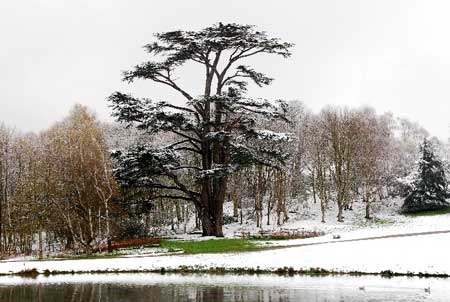
One of the four original cedars of Lebanon
Restoration begins
As the site began to open up and information began to amass, Janie commissioned a master plan to cover the restoration of the site and its development as a public attraction. This divided the site into project areas, to guide work on restoring the plantings and the garden buildings.
The very first building to be restored was the Gothic Temple. What remained of the temple had been encased in scaffolding for over 10 years, and could wait no longer. English Heritage funded most of the work (‘I think they felt sorry for us!' says Janie) and the temple was brought back from the brink of extinction.
Completing this first phase was a major staging post in the restoration project, both for the staff and for the project's wider reputation. For Janie, it was the high point of her working life so far.
‘Working for so long in the "jungle" as we had been, there was a need for the whole team to celebrate this first significant achievement,' she reflects.
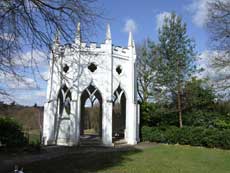
The Gothic Temple after restoration‘Standing in the Gothic Temple, looking at the reopened views, gave us confidence and helped us realise why we were there. It was a very important moment - showing the conservation world with this microcosm of restoration that we could do the job,' she recalls with pride - and some relief.
The Trust's aim from the outset was to restore Hamilton's landscape and all its buildings as accurately and faithfully as possible, but almost straight away this approach led to issues over the long-term maintenance of the buildings.
‘The buildings were of exquisite design, but they were flimsily built,' explains Janie. ‘Hamilton was short of money, and he was building in timber and rendering to look like stone, which caused huge problems for us.'
The team took a purist approach, putting everything back just as Hamilton had created it - albeit with a modern drainage system for the roof, which had not been there before.
‘We went a very painful route, keeping everything we could because it was Charles Hamilton. When you choose that method you have expensive on-going maintenance, and we've had to revisit the Gothic Temple at considerable expense,' says Janie.
Nowadays, she takes the view that it is the appearance and effect of the garden buildings in a landscape that matter more than putting them back exactly as they were originally made.
‘I think perhaps we needed more understanding the fun Hamilton had in creating these buildings. He was going for effect, so I think that is more important - keeping Hamilton's intentions,' she says.
However, Janie believes the lessons from the early phases of the restoration have been valuable. ‘I still think we had to go through that process. It's expensive, but otherwise you just jump to the easy option too quickly,' she reflects.
Fundraising
When Janie's job was first advertised, the chief executive of Elmbridge Borough Council was quoted as saying that the right person would have to be ‘a ranger, a plantsman, an administrator, a landscape historian and a landscape architect all in one'.
‘He forgot fundraiser - nothing happens without the money!' exclaims Janie. Indeed, finding and maintaining adequate funding for the project was always a struggle. After a number of attempts to work with professional fundraisers, Janie decided to save a salary and take on the work herself.
a valuable source of experience and advice She believes that working with trustees to make grant and trust applications and building personal relationships with key individual donors is the way forward on restoration projects such as Painshill.
‘Conservation doesn't tug at the heartstrings. Making public appeals is a bit of a waste of time in my view,' she states. ‘There is growing interest in supporting conservation, and those organisations and individuals who give generously are, in my experience, very knowledgeable and often wish for more involvement. They can be a valuable source of experience and advice as well as funds, as I found among the Painshill donors.'
Janie's alternative strategy clearly worked, because within 20 years of the formation of the Trust, £20 million had been raised for the project.
Opening to the public
Securing public access to the site turned out to be one of the most difficult tasks facing the Trust. The site is bounded by the A3 to the north and the River Mole to the south and southeast, while land to the west is privately owned. Access could only be gained across fields to the east from the Portsmouth Road, with a footbridge across the Mole.
There was substantial local opposition, and the council turned down three consecutive schemes for access and car parking. The issue was only eventually resolved through planning appeals and a public inquiry, causing the project some ten years of delay and considerable cost.
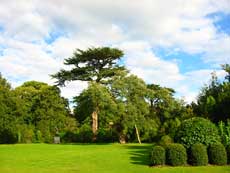
The AmphitheatreNevertheless, Janie feels that there were benefits from the delay in becoming a fully operational tourist attraction. The limited opening hours gave the restored landscape time to develop at a more natural pace, and volunteers were able to develop an excellent programme of guided tours for the limited times when the park was open.
The Trust also had time to develop an education strategy, which has stood Painshill in good stead since it became fully operational.
‘In retrospect I realise how lucky we were, that we had time and we could concentrate on doing a slow, careful job,' says Janie.
Leaving Painshill
In September 1994 Janie contracted a severe infection and septicaemia following a visit to Brazil, and needed major surgery. Following periods of absence, she then resumed work part-time for a number of years.
‘By this time Painshill enjoyed a strong and dedicated team of trustees, staff and volunteers, a world away from the early difficult, un-staffed days, so it wasn't such a problem for the project,' she reflects.
In 1998, Janie received an MBE for ‘services to historic landscape'. In the same year, the Painshill Park Trust won a Europa Nostra medal for ‘the exemplary restoration, from a state of extreme neglect, of a most important 18th-century landscape park and its extraordinary garden buildings'.
Janie retired from Painshill at the end of 2003, but remains in close touch with the current chief executive, Mike Gove , who consults her as and when needed.
a mutually beneficial dialogue Two years ago, Janie became a trustee of the newly formed Chiswick House and Gardens Trust, which with English Heritage and the London Borough of Hounslow is supervising the restoration of Chiswick House and gardens, with money from the Heritage Lottery Fund.
In many ways, she finds Chiswick reminds her of Painshill. ‘I have known and loved Chiswick for a long time, and although long open to the public the gardens had become very rundown,' she says. ‘I am hopeful that a mutually beneficial dialogue between the two projects can evolve.'
With Janie to help, one feels that Chiswick is in experienced and capable hands.
Sources
Burford, Janie. Personal interview, 10 April 2008.
